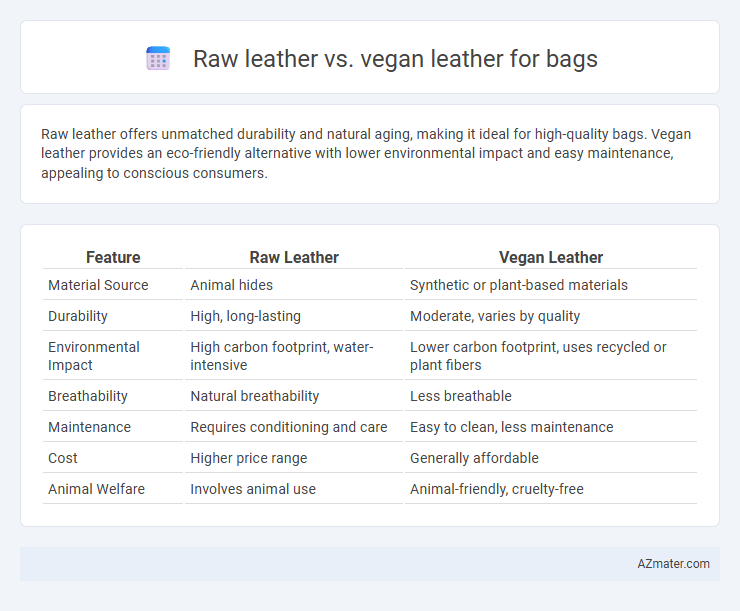Raw leather offers unmatched durability and natural aging, making it ideal for high-quality bags. Vegan leather provides an eco-friendly alternative with lower environmental impact and easy maintenance, appealing to conscious consumers.
Table of Comparison
| Feature | Raw Leather | Vegan Leather |
|---|---|---|
| Material Source | Animal hides | Synthetic or plant-based materials |
| Durability | High, long-lasting | Moderate, varies by quality |
| Environmental Impact | High carbon footprint, water-intensive | Lower carbon footprint, uses recycled or plant fibers |
| Breathability | Natural breathability | Less breathable |
| Maintenance | Requires conditioning and care | Easy to clean, less maintenance |
| Cost | Higher price range | Generally affordable |
| Animal Welfare | Involves animal use | Animal-friendly, cruelty-free |
Understanding Raw Leather: Origin and Composition
Raw leather originates from animal hides, primarily cowhide, which undergoes tanning processes to enhance durability and flexibility, making it a natural and resilient material for bags. Its composition includes collagen fibers that provide strength and a unique texture, allowing each bag to develop a distinct patina over time. Unlike synthetic alternatives, raw leather requires specific care to maintain its quality and longevity, emphasizing its premium and authentic appeal in bag craftsmanship.
What is Vegan Leather? Materials and Production
Vegan leather is a synthetic or plant-based alternative to raw leather, designed to mimic its texture and appearance without using animal hides. Common materials in vegan leather include polyurethane (PU), polyvinyl chloride (PVC), cork, apple peels, pineapple leaves (Pinatex), and mushroom-based mycelium, which offer varying degrees of durability and eco-friendliness. Its production involves layering or bonding these materials to create flexible, water-resistant sheets, often resulting in reduced environmental impact compared to traditional tanning processes used in raw leather manufacturing.
Durability: Raw Leather vs Vegan Leather
Raw leather offers superior durability due to its natural fiber structure and resistance to wear, often lasting several years with proper care. Vegan leather, typically made from polyurethane or plant-based materials, tends to have lower durability and may crack or peel over time under frequent use. The choice between raw and vegan leather depends on weighing long-term longevity against ethical and environmental considerations.
Environmental Impact of Raw and Vegan Leather
Raw leather production generates significant environmental impact due to the intensive water consumption, greenhouse gas emissions from livestock, and chemical pollutants from tanning processes. Vegan leather, often made from polyurethane or plant-based materials like pineapple leaves or mushroom, reduces carbon footprint and water usage but may involve synthetic polymers that are not biodegradable. Choosing vegan leather bags supports reduced deforestation and animal agriculture emissions but requires consideration of the environmental costs of plastic production and waste management.
Ethical Considerations in Leather Choices
Raw leather, derived from animal hides, raises ethical concerns related to animal welfare, environmental pollution from tanning processes, and carbon footprint. Vegan leather, made from synthetic or plant-based materials like polyurethane or pineapple leaves, offers a cruelty-free alternative with lower environmental impact, promoting sustainable fashion choices. Consumers prioritizing ethics often choose vegan leather to avoid animal exploitation and reduce ecological harm in bag production.
Aesthetics and Style: Comparing Appearance
Raw leather offers a rich, natural texture that develops a unique patina over time, enhancing the bag's classic and sophisticated appearance. Vegan leather provides a consistent, smooth finish with a wide range of colors and patterns, allowing for more experimental and modern design styles. Both materials cater to different aesthetic preferences, with raw leather favoring timeless elegance and vegan leather supporting versatile, cruelty-free fashion trends.
Maintenance and Care Requirements
Raw leather bags require regular conditioning with leather-specific oils to prevent drying and cracking, along with careful protection from water and direct sunlight to maintain their texture and durability. Vegan leather bags demand less intensive maintenance, generally needing only occasional wiping with a damp cloth to remove dirt, making them more resistant to water damage and staining. Over time, raw leather develops a unique patina that enhances its appearance, whereas vegan leather maintains a consistent look but may be less durable under rough conditions.
Cost Comparison: Which is More Affordable?
Raw leather bags typically cost significantly more due to the expense of processing animal hides and the craftsmanship involved, with prices often starting around $150 and going upwards. Vegan leather bags, made from synthetic or plant-based materials like polyurethane or pineapple fibers, generally start at a lower price point, approximately $50 to $100, making them more budget-friendly for consumers. The affordability of vegan leather combined with growing demand for cruelty-free products contributes to its cost-effectiveness in the handbag market.
Popular Brands Using Raw and Vegan Leather
Popular brands like Gucci and Prada often use raw leather for their luxury bags, emphasizing durability and classic aesthetics. In contrast, Stella McCartney and Matt & Nat focus on vegan leather alternatives, appealing to eco-conscious consumers with cruelty-free materials. Both raw and vegan leather options offer distinctive advantages, catering to different market preferences and ethical considerations.
Which Leather Type is Best for Bags?
Raw leather offers durability, natural aging, and a unique texture that enhances luxury bags, making it ideal for those seeking longevity and classic appeal. Vegan leather provides a cruelty-free, eco-friendly alternative with lower environmental impact and a variety of styles suitable for fashion-conscious consumers. Choosing the best leather type depends on prioritizing either sustainability and ethical production or traditional quality and durability for bags.

Infographic: Raw leather vs Vegan leather for Bag
 azmater.com
azmater.com